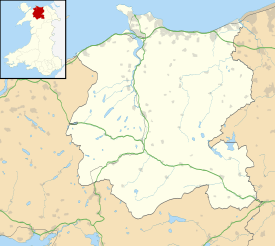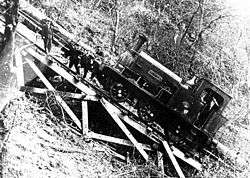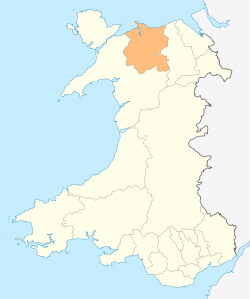Dolgarrog
| Dolgarrog | |
 A Pelton wheel in the grounds of Dolgarrog Power Station |
|
 Dolgarrog |
|
| Population | 446 (2011) |
|---|---|
| OS grid reference | SH768676 |
| Community | Dolgarrog |
| Principal area | Conwy |
| Ceremonial county | Clwyd |
| Country | Wales |
| Sovereign state | United Kingdom |
| Post town | CONWY |
| Postcode district | LL32 |
| Dialling code | 01492 |
| Police | North Wales |
| Fire | North Wales |
| Ambulance | Welsh |
| EU Parliament | Wales |
| UK Parliament | Aberconwy |
| Welsh Assembly | Aberconwy |
Coordinates: 53°11′28″N 3°50′38″W / 53.191°N 3.844°W







Dolgarrog is a village and community in Conwy County Borough, in Wales, situated between Llanrwst and Conwy, very close to the Conwy River. The village is well known for its industrial history since the 18th century and the Eigiau dam disaster, which occurred in 1925. The population was 414 at the 2001 Census,[1] increasing to 446 at the 2011 Census.[2]
The village is served by Dolgarrog railway station, a halt on the other side of the river Conwy.
History
The legend of Y Garrog
Believed to have been established around 1200 AD, Dolgarrog is said to have got its name from a flying dragon called Y Garrog. This mythical beast preyed on livestock and Dolgarrog (The Garrog's meadow) was the favourite meadow on which it swooped down from the heights above to carry off sheep. So serious were the losses that the farmers went on a dragon hunt armed with bows, arrows and spears.
One farmer, Nico Ifan, refused to go, claiming a dream had forewarned him the Garrog would cause his death. His fellow farmers laid a poisoned sheep's carcass on the heights above Eglwysbach across the river. The unsuspecting Garrog seized the bait, was caught and beaten to death.
Nico Ifan then came along to gloat over the dead dragon and cursed and kicked the corpse, whereupon the poisoned barbed wing of the Garrog pierced his leg thus fulfilling the death warning in his dream.
The Black Death
In the 1350s the Black Death took a heavy toll in the lower Conwy Valley, particularly among the bond tenants regulated by the King's officers from Aberconwy, Edward I's new English borough. Their visits and contacts in effect spread the disease. Some townships of villeins, or crown tenants, such as Dolgarrog, were swept away. People left their lands or hid, unable to pay the taxes on their holdings.
The Gunpowder Plot
A man privy to Guy Fawkes' Gunpowder Plot is said to have lived in the house Ardda'r Myneich (Monks Hill), whose ruins lie in the fields above the road between Porthlwyd and Dolgarrog bridges. Dr Thomas Williams (1550–1622), rector of St Peter's Church, Llanbedr-y-Cennin, was charged with having papist sympathies. He had warned Sir John Wynn of Gwydir to stay away from the Houses of Parliament on that fateful day.[3]
Industry
Dolgarrog's industrialisation began in the 18th century with a flour mill on Porthlwyd river to crush corn for local farmers. There was also a woollen mill at Dolgarrog bridge and the Abbey mill.
The successful Porthlwyd mill was expanded by John Lloyd, son of founder Richard Lloyd. As well as grinding flour, he bought machines to make paper and flock for bedding. Paper from Porthlwyd supplied local printers, including John Jones, printer of Trefriw and later Llanrwst.
In 1885 the villagers wanted to start a school at Porthlwyd. The old village of Dolgarrog appealed to Mr Robins, the then proprietor of the paper-mill. He let them turn a large empty room at the mill into a flourishing Sunday School, known locally as Ystafell y drws goch ("the room with the red door") to make sure the children did not wander into the mill workings.
The Dolgarrog sawmill of John Williams also flourished. It exported hundreds of tons of wooden railway sleepers for the new railways between 1845 and 1865. When the first sod was cut for the Conway and Llanrwst Railway track on 25 August 1860, on Lord Newborough's land at Abbey, Dolgarrog, it was John Williams who supplied the sleepers.
The Aluminium Works
The aluminium works (or "smelter") was originally planned in 1895. Water from reservoirs in the Snowdonia Mountains would provide the hydro-electricity needed to run the mill.
In 1907, aluminium production began in the factory and in 1916 a rolling mill was added. In 1924, the hydro-electric plant was built next to the aluminium works to assist in the running of the mill.
During the Second World War the aluminium works were under the control of the Ministry of Aircraft Production and provided parts for aircraft. It is rumoured that the Luftwaffe tried to destroy the works, but the bomber that was sent was shot down, and crash-landed in the mountains above the village.
Under the management of Henry Joseph Jack, the Aluminium Corporation of Dolgarrog acquired a controlling interest in the North Wales Power & Traction Company in 1918. This company had been established by Act of Parliament in 1904, taking over powers awarded to the Portmadoc, Beddgelert & South Snowdon Railway to build a hydro-electric power station in Nant Gwynant for railway purposes, as well as a 2 ft gauge electric railway serving the places named in the 1901 Portmadoc, Beddgelert & South Snowdon Railway Act. With the vision expanding to supply power to north Wales industries, the railway company was divested of its power-generating powers by another 1904 Act but remained under control of the power company; one of its assets was the 2 ft gauge horse-worked Croesor Tramway. Working with Pwllheli solicitor, and friend of the politician David Lloyd George, Evan Robert Davies and Dundee distiller Sir John Henderson Stewart Bt, Jack was a key player in the development of the Welsh Highland Railway, taking over the North Wales Narrow Gauge Railways, reconstructing part of the Croesor Tramway for steam working, linking them with a new railway around Beddgelert and connecting the whole to the Festiniog Railway at Portmadoc. The trio also acquired control of the Festiniog Railway Company and the Snowdon Mountain Tramroad & Hotels Company Ltd, running them all from Dolgarrog for a time.[4][5][6]
The factory is no longer operating, smelting having already ceased in the 1940s. Alcoa bought out the company Luxfer in 2000 and announced its closure in June 2002. Dolgarrog Aluminium Ltd formed in 2002 and acquired the assets from Alcoa in 2002. The factory closed in late 2007, and was demolished in 2009. In 2015 an artificial wave pool, Surf Snowdonia, opened on the site.[7]
'Garden City'
Prior to the construction of the Aluminium works, Dolgarrog had little in the way of a population. Much of the housing seen today along the main street in Dolgarrog was built by the Aluminium Corporation. In May 1908 the Welsh Coast Pioneer and Review reported their intentions -
The report that the Aluminium Corporation, Ltd., contemplate erecting numerous semi-detached houses for their employees, at Dolgarrog, of the character of a "Garden City" is exciting considerable interest, and the completion of the plans of the first portion of the scheme, by Mr A. Morley Jonee, architect, Llanrwst, are looked forward to. Included in the scheme is a commodious hotel and several shops. The Corporation will employ from 400 to 500 men, and these, with their families, will dwell in the "Garden City", giving a considerable impetus to the local trades, which will naturally benefit by the undertaking.
Whilst a limited number of houses was subsequently built, the Company did also build a hotel and a church. The Works also prompted more house building in neighbouring villages; three managers, for instance, lived in Trefriw.
Dam disaster
On 2 November 1925, the failure of two dams caused a flood that swamped the village of Dolgarrog, killing 16 people. The disaster was started by the failure of the Eigiau Dam, a gravity dam owned by the Aluminium Corporation. The water released from the reservoir flooded downstream, and overtopped the Coedty Dam, an embankment dam. This dam also subsequently failed, releasing the huge volume of water that flooded Dolgarrog.
Many more villagers could have been killed had they not been in the local theatre watching a film that night.
The disaster at Dolgarrog led the British parliament to pass the Reservoirs (Safety Provisions) Act in 1930 that introduced laws on the safety of reservoirs. This has since been updated, and the current one is the Reservoirs Act, 1975.
In 2004 a £60,000 memorial trail was created, explaining the tragic story to walkers. The trail takes visitors to where the boulders from the damaged dam reside. The project was opened by the last survivor of the dam disaster, Fred Brown, who on that night lost his mother and his younger sister.[8]
The construction of Eigiau dam had been facilitated by the construction of the Eigiau Tramway, which largely followed the route of the Cedryn Quarry Tramway from Dolgarrog. The incline was upgraded (and the lower section re-aligned), enabling steam engines to reach the starting point of the tramway, near Coedty reservoir. The tramway was built to standard gauge, but was subsequently relaid in narrow gauge (from about 1916) when the Cowlyd Tramway was begun. This latter tramway branched off from the Eigiau tramway at the top of the Dolgarrog incline.
The line of the railway incline has today been replaced by a second pipeline, and the adjoining hillsides are wooded. However, there is a public footpath which goes up the hillside to the left of the pipeline, and in places the timberwork can still be seen. Today the left pipeline (viewed from Dolgarrog) carries water from Llyn Cowlyd, the right pipeline carries water from Coedty reservoir.
To the south of the Health Centre the remains of a lower incline (the old route of the Cedryn Tramway) can still be seen. This incline, which joined the upper section a little above the village, passed through a short tunnel under the road at Tyddyn Isaf, visible from the main road.
From here the original quarry tramway continued across the marshland to the edge of the River Conwy at Porth Llwyd wharf.
Garden Art
Commenced in 2001, Garden Art[9] is a local business that brings together both tasteful and unusual antique and contemporary garden statuary, tubs, architectural antiques, and specimen plants, all of which are displayed within a 10-acre (40,000 m2) site in the natural beauty of the Snowdonia National Park in Wales. As well as selling all kinds of sculptures, it also claims to have the "World's Largest Hedge Maze" covering over 2 acres (8,100 m2) of land.
The Lord Newborough
Built during the 1800s, the building sustained heavy damage when the dam burst in 1925, but was quickly repaired. It was the only restaurant in the village. Mostly served traditional Welsh food, sourced locally from the Conwy Valley. The pub closed for business in September 2010, and is now a private dwelling.
References
- ↑ Neighbourhood Statistics (2004-04-28). "View or Download Data: view full dataset". Neighbourhood Statistics. Retrieved 2012-02-11.
- ↑ "Community population 2011". Retrieved 22 May 2015.
- ↑ "icNorthWales - The killing fields of Dolgarrog". Icnorthwales.icnetwork.co.uk. Retrieved 2012-02-11.
- ↑ Johnson, Peter; An Illustrated History of the Welsh Highland Railway; Oxford Publishing Co, 2nd edition 2009
- ↑ Johnson, Peter; An Illustrated History of the Festiniog Railway; Oxford Publishing Co, 2007, reprinted 2014
- ↑ Johnson, Peter; An Illustrated History of the Snowdon Mountain Railway; Oxford Publishing Co, 2010
- ↑ Claire Marshall (31 July 2015). "Wales surf wave generator starts up". BBC News. Retrieved 2 August 2015.
- ↑ "'Nov. 2nd 1925. The Dolgarrog Disaster' (1925) :: Gathering the Jewels". Education.gtj.org.uk. 1925-11-02. Retrieved 2012-02-11.
- ↑ "Garden Art - Garden Statues and Ornaments (Japanese style a speciality) and Conwy Valley Maze". Gardenartdirect.co.uk. Retrieved 2012-02-11.
External links
| Wikimedia Commons has media related to Dolgarrog. |
- A Vision of Britain Through Time
- British Listed Buildings
- Dolgarrog Railway Society
- Gathering the Jewels: The Dolgarrog Disaster
- Geograph
- IC North Wales: The Killing Fields of Dolgarrog
- Office for National Statistics
- Old Photos
